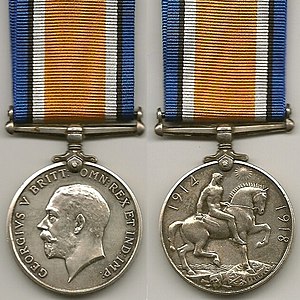The World War I Victory Medal was a United States service medal designed by James Earle Fraser of New York City under the direction of the Commission of Fine Arts.

The Pacific Star is a military campaign medal instituted by the United Kingdom in May 1945 for award to British and Commonwealth forces who served in the Pacific Campaign from 1941 to 1945, during the Second World War.
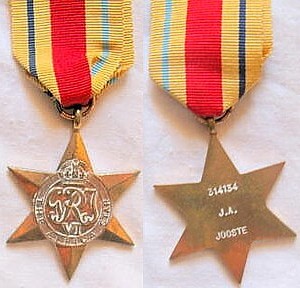
The Africa Star is a military campaign medal, instituted by the United Kingdom on 8 July 1943 for award to British and Commonwealth forces who served in North Africa between 10 June 1940 and 12 May 1943 during the Second World War.
British campaign medals are awarded to members of the British Armed Forces, Allied forces and civilians participating in specified military campaigns. Examples include the Defence Medal, for homeland defence in World War II, and the Atlantic Star for World War II sea service in the Atlantic.

The 1914 Star, colloquially known as the Mons Star, is a British World War I campaign medal for service in France or Belgium between 5 August and 22 November 1914.

The 1939–1945 Star is a military campaign medal instituted by the United Kingdom on 8 July 1943 for award to British and Commonwealth forces for service in the Second World War. Two clasps were instituted to be worn on the medal ribbon, Battle of Britain and Bomber Command.

The Crimea Medal was a campaign medal approved on 15 December 1854, for issue to officers and men of British units which fought in the Crimean War of 1854–56 against Russia. The medal was awarded with the British version of the Turkish Crimea Medal, but when a consignment of these was lost at sea, some troops received the Sardinian version.

The Burma Star is a military campaign medal, instituted by the United Kingdom in May 1945 for award to British and Commonwealth forces who served in the Burma Campaign from 1941 to 1945, during the Second World War.
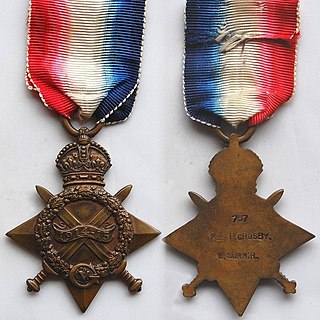
The 1914–15 Star is a campaign medal of the British Empire which was awarded to officers and men of British and Imperial forces who served in any theatre of the First World War against the Central European Powers during 1914 and 1915. The medal was never awarded singly and recipients also received the British War Medal and Victory Medal.
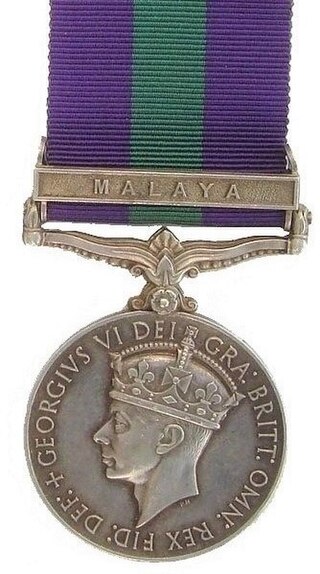
The General Service Medal was instituted to recognise service in minor Army and Royal Air Force operations for which no separate medal was intended. Local forces, including police, qualified for many of the clasps, as could units of the Indian Army prior to 1947.

The General Service Medal, is a campaign medal of the United Kingdom introduced in 1962 to replace both the General Service Medal (1918), as awarded to the Army and RAF, and the Naval General Service Medal (1915). The 1962 GSM was awarded until 2007, when it was replaced by the Operational Service Medal. In 2015 the General Service Medal (2008) was introduced.
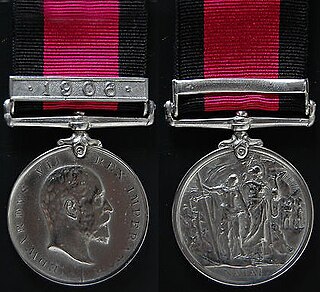
The Natal Native Rebellion Medal was a British campaign medal. It was authorised in 1907 for service in Natal during a Zulu revolt against British rule and taxation in 1906. The 1906 Clasp to the medal was awarded to those who had served for more than fifty days.

The Victory Medal is a United Kingdom and British Empire First World War campaign medal.
Pip, Squeak and Wilfred was a British strip cartoon published in the Daily Mirror from 1919 to 1956, as well as the Sunday Pictorial in the early years. It was conceived by Bertram Lamb, who took the role of Uncle Dick, signing himself (B.J.L.) in an early book, and was drawn until c. 1939 by Austin Bowen Payne, who always signed as A. B. Payne. It concerned the adventures of an orphaned family of animals. Pip, who assumed the "father" role, was a dog, while the "mother", Squeak, was a penguin. Wilfred was the "young son" and was a rabbit with very long ears.

The South Africa Medal (1880), often referred to as the Zulu War Medal, is a campaign medal instituted in 1880 and awarded by the British Government to members of the British Army, Royal Naval Brigade and Colonial Volunteers who were involved in a series of South African tribal wars in the Cape of Good Hope, Colony of Natal and Transvaal between 1877 and 1879, most notably for the Anglo-Zulu War of 1879.

The Victory Medal (South Africa) is the Union of South Africa's version of the Victory Medal (United Kingdom), a First World War campaign medal of Britain and her colonies and dominions. The medal, never awarded singly, was awarded to all those South Africans who were awarded the 1914–15 Star or the British War Medal.

The Royal Air Force Long Service and Good Conduct Medal is a medal awarded to regular members of the Royal Air Force in recognition of long service. It was instituted by King George V in 1919, the year following the establishment of the world's first independent air force. At first, the medal was awarded to Regular Force non-commissioned officers and airmen of the Royal Air Force. The award criteria were later relaxed to also allow the award of the medal to officers who had served a minimum period in the ranks before being commissioned. Since 2016, it is awarded to all regular members of the RAF, including officers who had never served in the ranks.

The Naval Good Shooting Medal is a Naval gunnery medal that was instituted in 1902, for award to the gunner on each type of ship's gun in the fleet who achieved first place in the gunnery competitions held during the Annual Fleet Competitions. From 1903 to 1914 medals were awarded annually, until the competition was discontinued upon the outbreak of the First World War.

The Queen's Medal for Champion Shots of the New Zealand Naval Forces was retrospectively instituted for New Zealand in 1958, the first medal having already been awarded in 1955. The medal is a Naval counterpart of the Queen's Medal for Champion Shots in the Military Forces and the Queen's Medal for Champion Shots of the Air Forces. One medal can be awarded annually to the champion shot of a small-arms marksmanship competition held by the Royal New Zealand Navy.

The Queen's Medal for Champion Shots of the Royal Navy and Royal Marines was instituted in 1966. The medal is a Naval counterpart of the Queen's Medal for Champion Shots in the Military Forces and the Queen's Medal for Champion Shots of the Air Forces and is identical to the Queen's Medal for Champion Shots of the New Zealand Naval Forces that had been instituted in 1958. One medal can be awarded annually to the champion shot of a small-arms marksmanship competition, held by the Royal Navy and Royal Marines.
